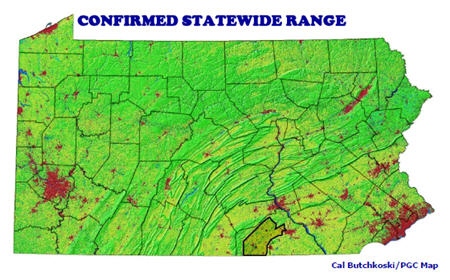 Print
Print
Current Status: In Pennsylvania, the least shrew is endangered and protected under the Game and Wildlife Code. It also is a priority species in the state's Wildlife Action Plan. Nationally, it has no special protection.
Population Trend: The least shrew (Cryptotis parva) was thought to be widespread throughout much of Pennsylvania, although mainly in localized populations, during the mid 1900s. During that period, surveys conducted across the state found this mid-sized insectivore in every region of Pennsylvania except the northcentral counties. More recent surveys suggest the least shrew has now disappeared from many of the sites where it was once present and that it now is restricted to southeastern counties. Since 1990, surveys have found the least shrew at only three isolated sites in York and Adams counties, with possibly one of the most extensive populations occurring within the Eisenhower National Historic Site near Gettysburg. Unknown isolated populations may still occur elsewhere in the state. If so, they would most likely be in jeopardy of localized extirpation. Pennsylvania listed the least shrew as endangered in 1990. The species is found throughout much of the eastern United States, ranging from New York south to Florida and through the Midwest into Central America. The least shrew appears to be secure globally.
Identifying Characteristics: The total length of the least shrew is from three to 3 ½ inches. Its tail length ranges from ½ to ¾ inches, which is the shortest tail of all Pennsylvania shrews. The only other species of shrew with a short tail, the more common northern short-tailed shrew, is larger (total length is four to five inches) and is dark slate-gray in color. In Pennsylvania the majority of least shrews have a pale to dark brown back and a pale to light brown belly, but fur color varies from dark gray to black in most of the species' North American range. The least shrew's ears are hidden beneath its fine, velvety fur.
Biology-Natural History: The least shrew is a grassland species restricted to habitats that are free from grazing and intensive agricultural practices. It is active year-round, mostly during evening hours. It commonly forages for food in runways created by meadow voles, but also constructs its own narrow passageways within vegetation for foraging and dispersal. Least shrews feed primarily on insects and their larva, earthworms, spiders and sometimes snails. It occasionally exhibits hoarding behavior, unusual among shrews. It is sometimes referred to as the "bee mole" because it has been found to infrequently enter bee hives and feed on the brood. Several researchers have noted that the least shrew appears to be colonial or at least somewhat social, forming nests occupied by several adults, often during winter months, rather than occurring singly like most shrew species. It is believed to have up to three litters per year between March and November, averaging five young per litter. Its nest is ball-like, three to five inches in diameter, usually found under rocks, logs, stumps or old boards, and has two entrances with tunnels to the surface. Because of their high metabolic rates and food needs, least shrews are not good dispersers and seem to be very restricted locally. Much of the biology of this species in Pennsylvania remains unknown.
Preferred Habitat: Unlike other shrews, the least shrew prefers non-forested habitats, which were widespread in
 Pennsylvania prior to the 1960s as the result of forest-cutting around 1900. Old sedge meadows and non-agricultural fields are less common now, with large blocks of grassland habitat restricted to southern tier counties in the central and eastern part of the state.
Pennsylvania prior to the 1960s as the result of forest-cutting around 1900. Old sedge meadows and non-agricultural fields are less common now, with large blocks of grassland habitat restricted to southern tier counties in the central and eastern part of the state.
Reasons for Being Endangered: Traditional farming practices have been replaced by extensive agricultural monocultures throughout much of the least shrew's former Pennsylvania range, resulting in the loss of hayfields, meadows and fencerows. This, coupled with the regeneration of forestlands, and housing or industrial development of other lands, has reduced the availability of least shrew habitat. In many areas where its habitat does still exist it is fragmented, isolating shrew populations and increasing the possibility of chance events leading to localized eradication of those populations.
Management Programs: Management needs include increased understanding of the least shrew's habitat requirements, identification of areas with suitable habitat, and conservation planning that incorporates adaptive management for grassland nesting birds as well as the least shrew. Research needs include determining home range, optimal habitat characteristics, and types of habitat used for dispersal.
Sources:
Kirkland G. L. Jr., Hart J. A. 1999. Recent records for ten species of small mammals in Pennsylvania. Northeastern Naturalist 6(1):1-18.
Kurta A. 1995. Mammals of the Great Lakes Region. The University of Michigan Press. Ann Arbor, Michigan. 376 pp.
Merritt J. F. 1987. Guide to the mammals of Pennsylvania. University of Pittsburgh Press. Pittsburgh, PA. 408 pp.
Whitaker, J. O. Jr., Hamilton, W. J. Jr. 1998. Mammals of the Eastern United States. Comstock Publishing Associates, Cornell University Press. Ithaca, New York. 583 pp.
Suggested Further Reading:
Merritt J. F. 1987. Guide to the mammals of Pennsylvania. University of Pittsburgh Press. Pittsburgh, PA. 408 pp.
By Eileen Butchkoski
Pennsylvania Game Commission
9/9/2014